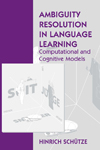

|
|
|
|

Ambiguity Resolution in Language LearningComputational and Cognitive Models This volume is concerned with how ambiguity and ambiguity resolution are learned, that is, with the acquisition of the different representations of ambiguous linguistic forms and the knowledge necessary for selecting among them in context. Schütze concentrates on how the acquisition of ambiguity is possible in principle and demonstrates that particular types of algorithms and learning architectures (such as unsupervised clustering and neural networks) can succeed at the task. Three types of lexical ambiguity are treated: ambiguity in syntactic categorization, semantic categorization, and verbal subcategorization. The volume presents three different models of ambiguity acquisition: Tag Space, Word Space, and Subcat Learner, and addresses the importance of ambiguity in linguistic representation and its relevance for linguistic innateness. is the Chair of Theoretical Computational Linguistics at the Institute for Natural Language Processing, University of Stuttgart. Contents
1/31/97 ISBN (Paperback): 1575860740 (9781575860749)
Subject: Linguistics; Second Language Acquisition; Computational Linguistics |
Distributed by the
University of Chicago Press |
|
pubs @ csli.stanford.edu
|
CSLI Publications
Stanford University Cordura Hall 210 Panama Street Stanford, CA 94305-4101 (650) 723-1839 |